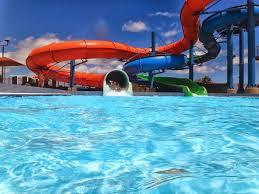First of all, this was a rare occurrence. So this is not to instill fear in anyone.
Yet, this tragedy did happen – and since there are simple steps that can make a small risk even smaller, should water park patrons take them? It depends on how risk averse you are, so that's for each of us to decide.
In case you hadn't heard, here's what happened to a 29-year-old man, as best we know, who visited a Texas water park and contracted a rare brain infection from a waterborne amoeba before dying two weeks ago.
A spinal tap found that Fabrizio Stabile was infected with an amoeba called Naegleria fowleri, a single-cell organism that eats and destroys brain tissue if it reaches that organ. While it is unusual for it to get to the brain, when it does it's carried by a rush of water entering the nostrils. And if proper maintenance at water parks is not performed, it can thrive in the warm water found there.
 The amoeba, which "causes primary amebic meningoencephalitis (PAM), a disease of the central nervous system," according to the Centers for Disease Contol and Prevention, is "naturally found in warm freshwater environments such as lakes and rivers, naturally hot (geothermal) water such as hot springs, warm water discharge from industrial or power plants, geothermal well water," as well as in "poorly maintained or minimally chlorinated swimming pools. ... Naegleria fowleri grows best at higher temperatures up to 115o F." (graph courtesy: CDC)
The amoeba, which "causes primary amebic meningoencephalitis (PAM), a disease of the central nervous system," according to the Centers for Disease Contol and Prevention, is "naturally found in warm freshwater environments such as lakes and rivers, naturally hot (geothermal) water such as hot springs, warm water discharge from industrial or power plants, geothermal well water," as well as in "poorly maintained or minimally chlorinated swimming pools. ... Naegleria fowleri grows best at higher temperatures up to 115o F." (graph courtesy: CDC)
And while cases of the amoeba eating brain tissue are rare, they also are almost always deadly.
"There have been 143 PAM infections from 1962 through 2017 with only four survivors," the CDC reports. "These infections have primarily occurred in 15 southern-tier states, with more than half of all infections occurring in Texas and Florida." Naegleria fowleri has not been found in sea water, nor can it survive there.

Stabile, a New Jersey resident and known outdoor enthusiast, was reportedly surfing in the wave pool at the BSR Cable Park and Surf Resort in Waco, Texas. (Here's some video of man-made wave surfing at the resort.) After returning home he felt the effects of a headache, and soon after lost the ability to speak coherently. Stabile was then hospitalized before dying Sept. 21. (photo courtesy: The Fabrizio Stabile Foundation via GoFundMe)
The CDC stated that this was the first confirmed PAM case since 2016. The park has been closed since his death and tests on the water are being conducted.
The amoeba ordinarily eat bacteria found in warm freshwater, but it seeks other food sources when it's forced towards the human brain. If the amoeba is swallowed the brain is unaffected, and it doesn't create an infection that's contagious among humans. To be harmful it must make its way to the brain, and that pathway is through the nasal cavity. Therefore, closing off that avenue can nearly eliminate any risk.
The most direct and obvious way to do that is to wear nose clips when in freshwater bodies, pools or water parks. Avoiding putting one's head underwater as much as possible can help as well. But most importantly, avoid any situations where a surge of warm, freshwater comes towards the face. Simply holding your nose can help in many instances, as well.
To that point, some activities that create a water surge should be done with caution. For instance, jumping feet first from an elevated area, like a rock outcropping, can send a rush of water up the nose. Meanwhile, water skiing, where a sudden fall can propel water towards the face, can be done more safely while wearing nose clips.
Of course, we face all kinds of risk every day. If we wanted to completely guard ourselves we'd never get out of bed in the morning (which might present its own risk of some sort) and keep the covers over our head. So undoubtedly there will be those who will criticize even the idea of taking any kind of precaution in this area.
Regardless, having information allows each one of us to decide how to proceed. So dive in to whichever end of the pool suits you best.




